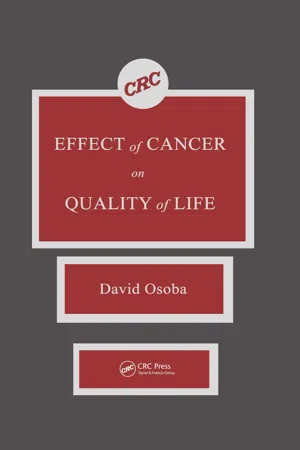
Effect of Cancer On Quality of Life
David Osoba
- 368 Seiten
- English
- ePUB (handyfreundlich)
- Über iOS und Android verfügbar
Effect of Cancer On Quality of Life
David Osoba
Über dieses Buch
This book is comprised of extensive reviews and instructional chapters that discuss the quality of life in several aspects of cancer. The first six chapters deal with conceptual issues relating to measuring quality of life in adult and pediatric populations with cancer. The next five chapters provide practical information on how to select quality-of-life measures, the statistical analysis of trials, economic evaluations to be considered, and some possible abuses of quality-of-life measures. Five chapters review the results of studies using selected quality-of-life measures and provide recent information on their performance. These are followed by three chapters dealing with specific issues relating to nausea and vomiting associated with cancer therapy. Three chapters are devoted to the problems of assessing and controlling pain in patients who have cancer. There are also two chapters that deal with the quality of life in palliative care. Effect of Cancer on Quality of Life is intended for all who have an interest in measuring the quality of life in patients with cancer. This includes investigators who are just entering the field and can benefit from instructions on how to conduct quality-of-life research, as well as those who are experienced in conducting this kind of research.
Häufig gestellte Fragen
Information
Chapter 1
PERSPECTIVES ON QUALITY OF LIFE AND THE GLOBAL CANCER PROBLEM
I. | Introduction |
II. | Current Perspectives in Controlling Cancer |
III. | Strategies and Priorities of the World Health Organization (WHO) |
IV. | Challenges |
V. | Conclusions |
References | |
I. INTRODUCTION
II. CURRENT PERSPECTIVES IN CONTROLLING CANCER
III. STRATEGIES AND PRIORITIES OF THE WORLD HEALTH ORGANIZATION (WHO)
Tumora | No. of casesb | Primary prevention | Early diagnosis | Curative therapyc | Palliative care |
|---|---|---|---|---|---|
Stomach | 670 | +d | − | − | + + |
Lung | 660 | + + | − | − | + + |
Breast | 572 | − | + + | + + | + + |
Colon/rectum | 572 | + | + | + | + + |
Cervix | 466 | + | + + | + + | + + |
Mouth/pharynx | 379 | + + | + + | + + | + + |
Esophagus | 310 | − | − | − | + + |
Liver | 251 | + + | − | + + |



Inhaltsverzeichnis
- Cover
- Title Page
- Copyright Page
- Preface
- Acknowledgments
- The Editor
- Contributors
- Table of Contents
- Chapter 1 Perspectives on Quality of Life and the Global Cancer Problem
- Chapter 2 Measuring Functioning, Well-Being, and Other Generic Health Concepts
- Chapter 3 Measuring the Effect of Cancer on Quality of Life
- Chapter 4 Prediction of Psychosocial Distress in Patients with Cancer
- Chapter 5 N of 1 Randomized Controlled Trials for Investigation of Quality of Life in Cancer
- Chapter 6 Quality of Life of the Treatment Process in Pediatric Oncology: An Approach to Measurement
- Chapter 7 A Practical Guide for Selecting Quality-of-Life Measures in Clinical Trials and Practice
- Chapter 8 Incorporation of Quality-of-Life Assessment into Clinical Trials
- Chapter 9 Statistical Analysis of Trials Assessing Quality of Life
- Chapter 10 Economic Evaluations of Cancer Care — Incorporating Quality-of-Life Issues
- Chapter 11 Uses (and Some Possible Abuses) of Quality-of-Life Measures
- Chapter 12 Cancer Patients’ Unmet Support Needs as a Quality-of-Life Indicator
- Chapter 13 The Spitzer Quality-of-Life Index: Its Performance as a Measure
- Chapter 14 The EORTC Core Quality-of-Life Questionnaire: Interim Results of an International Field Study
- Chapter 15 Quality of Life in Breast Cancer
- Chapter 16 Women’s Sexuality Following Breast Cancer
- Chapter 17 Methodological Issues in Anti-Emetic Studies
- Chapter 18 Anticipatory Nausea and Vomiting Side Effects Experienced by Cancer Patients Undergoing Chemotherapy Treatment
- Chapter 19 Selective 5-HT3, Receptor Antagonists: A Novel Class of Antiemetics
- Chapter 20 Pain and Quality of Life: Theoretical Aspects
- Chapter 21 Pain Assessment in Cancer
- Chapter 22 Clinical Trials in Pain Control
- Chapter 23 Quality-of-Life Research in the European Palliative Care Setting
- Chapter 24 Quality-of-Life Research in Hospice Care
- Index